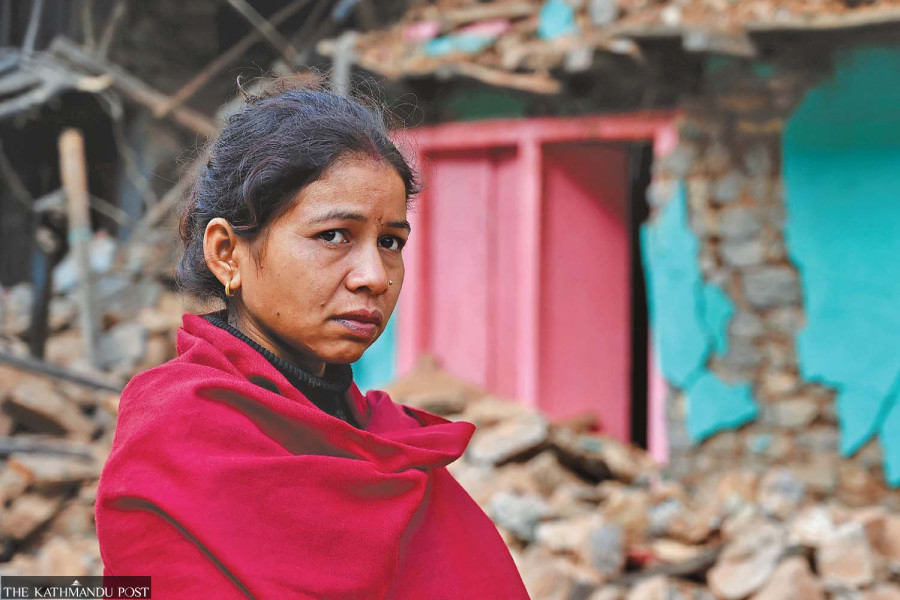
Two days after the devastating Jajarkot earthquake, the government is already weighing various long-term reconstruction plans.
It will prioritise the reconstruction of private homes and other community infrastructures in the aftermath and is considering a pair of options to do so.
As many as 153 people died and around 8,000 houses—both public and private—were damaged in Friday’s earthquake that mainly hit Jajarkot and Rukum West districts.
After the December 2021 dissolution of the National Reconstruction Authority (NRA) formed after the big earthquake of 2015, some government officials believe a new approach is needed for rebuilding private houses and other physical infrastructure following the Jajarkot earthquake.
Another group of officials are of the view that revising existing laws and policies is necessary to expedite reconstruction. After completing major reconstruction work in the aftermath of the 2015 Gorkha earthquake, the NRA had handed over the remaining responsibilities, assets, records and related documents to the National Disaster Risk Reduction and Management Authority (NDRRMA).
“It appears that the reconstruction efforts in Nepal following natural disasters like earthquake and others, need to continue for a long time,” said a senior government official familiar with the issue, adding, “at times there may be an urgency for reconstruction, but due to various challenges, we might not be able to expedite work immediately. To address this situation, we are considering two options—either amend the existing laws and policies related to reconstruction, or set up a new body.
“However no decision has been taken,” the official said, adding that the two options were discussed during a recent meeting of the High-level Disaster Risk Reduction and Management Committee chaired by Prime Minister Pushpa Kamal Dahal.
During the 13th meeting of the National Council of Disaster Risk Reduction and Management Committee on Sunday, Prime Minister Dahal said a new law, policy and structure are needed to effectively carry out rehabilitation and reconstruction efforts.
Our experience after the 2015 earthquake was unsatisfactory, especially in terms of studying the geology and developing settlements for those in geologically vulnerable areas, said the secretary at the Office of the Prime Minister and Council of Ministers, Narayan Prasad Bhatta.
In order to assess the damage caused by Friday’s earthquake, the Ministry of Urban Development has sent a team of technical experts and engineers to Jajarkot and Rukum West.
When the team of experts submits its report, necessary decisions will be taken, an official at the Ministry of Urban Development said. The team of experts and engineers left for the quake-hit districts on Monday, the official added.
Another senior official at the Office of the Prime Minister and Council of Ministers said Nepal is fragile in terms of earthquakes and other natural disasters, so they were considering amending old law or bringing a new one so that it can be automatically activated during emergencies.
“Our procurement-related laws are sluggish and do not facilitate fast-track procurements in an emergency. We need to reform them and change our legal regime in order to expedite procurement. This was also something we realised during the Covid pandemic,” the official said.
But he said there have been preliminary discussions about setting up a new mechanism in order to expedite reconstruction in quake-hit areas.
Also, during his meeting with a delegation from the Rastriya Swatantra Party, Prime Minister Dahal indicated that some legislative adjustments are needed as existing laws are not sufficient to step up reconstruction and rehabilitation.
“As per our initial estimates, around 3,000 homes were fully damaged while an additional 5,000 suffered partial damage,” said Narayan Prasad Bhattarai, spokesman for the home ministry. “The final tally on the damaged homes has yet to come.”
In April 2015, a 7.8 magnitude earthquake and strong aftershocks that continued for several days had damaged nearly 800,000 houses besides killing nearly 9,000 people, according to the Post Disaster Needs Assessment Report-2015.
Likewise, 920 heritage sites, 402 monasteries, 7,553 schools, 1,197 health institutions, 415 government buildings, 216 buildings of security agencies and 672 km of road in various districts were damaged.
Chief Secretary Baikuntha Aryal told the Post that officials are seriously mulling ways to expedite post-earthquake reconstruction efforts.
Regarding Friday’s earthquake, the complete assessment of the damage has yet to come, but initial estimates have put property losses at around Rs10 billion, said officials.
A Cabinet meeting on Sunday decided that Jajarkot would be the base area for the reconstruction drive, with the Ministry of Urban Development leading the efforts.
Rebuilding will be completed within a year and new structures will be fully quake resistant, according to the decision made public after the Cabinet meeting.
“I have heard that the government is going to hand over reconstruction tasks to provincial governments,” said Govinda Raj Pokharel, former chief executive officer of the National Reconstruction Authority. “We don’t need any new structure or mechanism for reconstruction as the provinces have their own planning commissions, which, if needed, can consult the centre for expert advice and manpower. Provincial governments are well-suited to carry out reconstruction work,” said Pokharel, who led the preparation of the post-disaster needs assessment report in 2015.
Besides tearing down private and public houses and buildings, the earthquake on Friday also damaged roads and bridges. The quake caused three large landslides along the Pasagad-Rimna section in the Bheri Corridor (Jajarkot-Dunai), damaging the road section and disrupting vehicular movement. Likewise, it triggered a large landslide at Khalanga-Panchkatiya section.
A bridge in the Rimna area of Jajarkot also suffered minor damage, according to the Department of Roads.
A Cabinet meeting on Sunday decided to carry out reconstruction of the damaged infrastructure by formulating an integrated action plan. As per the Cabinet decision, the Ministry of Urban Development will take forward the reconstruction efforts.
Bhatta, the spokesperson at the Office of the Prime Minister and Council of Ministers, said no decision has been taken with regard to setting up a dedicated mechanism or legal revisions. “But we are consulting various line ministries to enact legal reforms to expedite reconstruction efforts,” Bhatta added.











